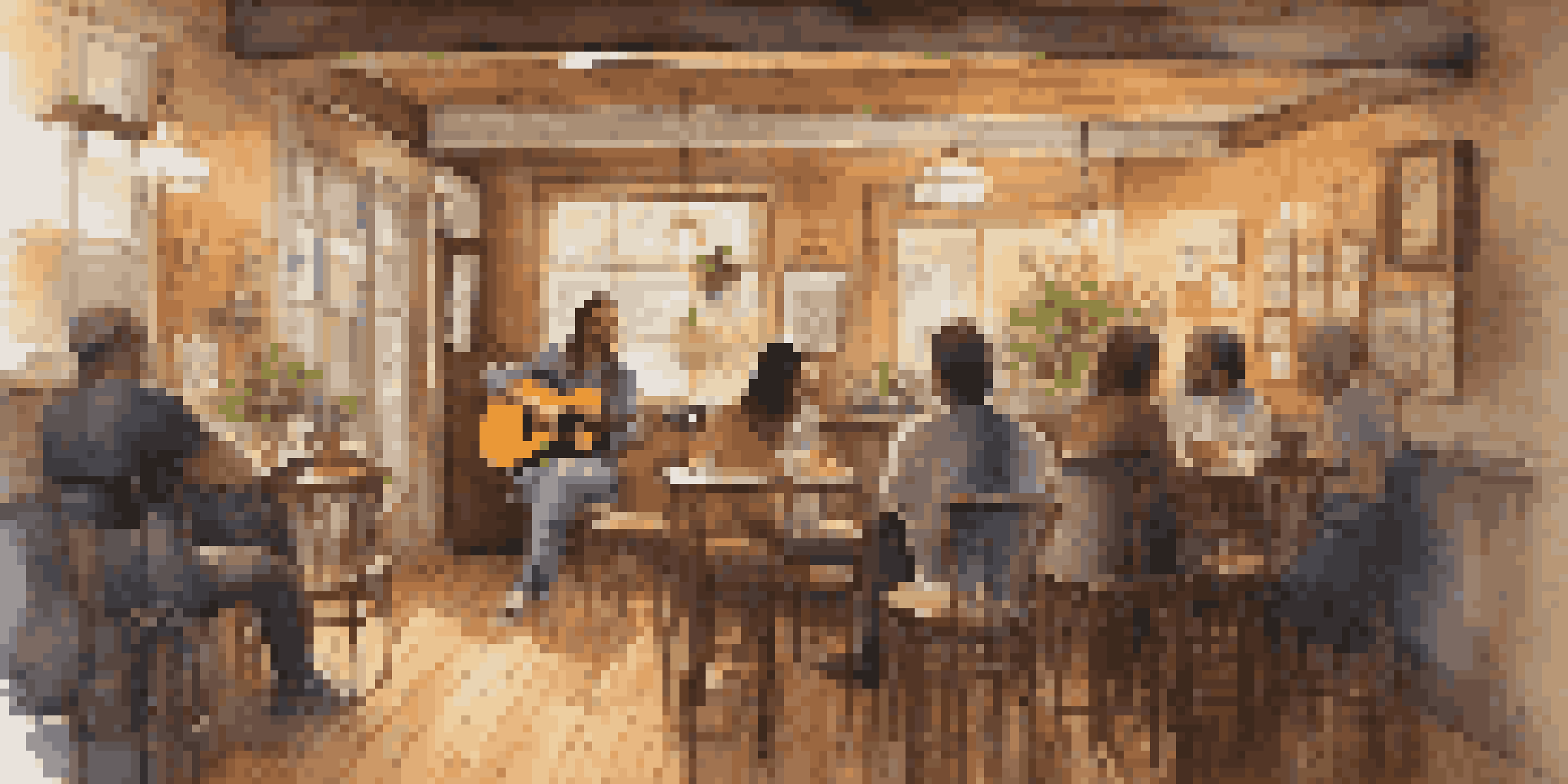Crossover Genres: Acoustic vs. Electric Music Blends

Understanding Acoustic and Electric Music Basics
Acoustic music relies on natural sounds produced by instruments like guitars, pianos, and violins. These instruments don't require amplification, giving acoustic music its warm and organic feel. In contrast, electric music incorporates electronic instruments and technology, such as electric guitars, synthesizers, and digital effects, creating a more vibrant and amplified sound.
Music is the shorthand of emotion.
The beauty of acoustic music lies in its simplicity and the raw emotion it conveys, often drawing listeners in with its authenticity. Electric music, on the other hand, opens up a world of possibilities with its use of effects and production techniques, allowing for a broader range of auditory experiences. Together, they represent two ends of a musical spectrum that often intersect.
By understanding the foundational elements of both genres, we can appreciate how they can blend to create unique crossover styles. This fusion often results in music that resonates with a diverse audience, bringing together the best of both worlds.
Key Characteristics of Acoustic Music
Acoustic music is characterized by its emphasis on natural sound, allowing listeners to connect deeply with the artist's intention. The lack of electronic manipulation means that every note and chord played is a direct reflection of the musician's skill and emotion. This authenticity often translates into a more intimate listening experience.

Live performances of acoustic music are particularly captivating; the rawness of the sound can evoke powerful emotions, drawing audiences into the moment. Think of a small café where a singer-songwriter strums their guitar, creating a shared experience that feels personal and heartfelt. Such moments highlight the unique qualities of acoustic music.
Acoustic vs. Electric Music
Acoustic music offers a natural, organic sound, while electric music utilizes technology to create a vibrant and amplified auditory experience.
Another defining feature is the genre's versatility. Acoustic elements can be found in various styles, from folk and country to classical and pop, showcasing how these natural sounds can adapt and thrive across different musical landscapes.
Defining Features of Electric Music
Electric music thrives on its innovative use of technology, incorporating a wide array of instruments and sound effects. Electric guitars, keyboards, and drum machines create a dynamic soundscape that can range from upbeat and energetic to dark and moody. This versatility is one reason electric music appeals to such a broad audience.
The beautiful thing about music is that it transcends language.
Moreover, the production techniques employed in electric music, like looping, sampling, and synthesizing, offer endless possibilities for creativity. Artists can manipulate sound in ways that acoustic musicians typically can't, leading to complex arrangements and immersive listening experiences. This creative freedom often results in groundbreaking music that pushes boundaries.
Electric music also fosters a sense of community among fans, with genres like electronic dance music (EDM) and rock drawing large crowds at festivals and concerts. The shared experience of enjoying high-energy performances further solidifies the genre’s impact on contemporary music culture.
The Rise of Crossover Genres
As music evolves, the lines between acoustic and electric genres have blurred, giving rise to exciting crossover styles. Artists today often blend elements from both worlds, creating unique sounds that defy traditional categorization. This fusion allows musicians to explore their creativity while reaching varied audiences.
For example, artists like Ed Sheeran and John Mayer seamlessly incorporate electric guitar riffs into their acoustic performances, creating a hybrid sound that resonates with fans of both genres. These crossovers not only showcase the versatility of musicians but also highlight the evolving nature of music itself.
Blending Genres for Innovation
The fusion of acoustic and electric elements has led to the rise of crossover genres, allowing artists to explore creativity and reach diverse audiences.
The rise of streaming platforms has further facilitated this blending of genres, as listeners are exposed to a wider range of styles. This accessibility has encouraged artists to experiment, leading to an explosion of innovative sounds that keep the music landscape fresh and exciting.
Notable Artists Blending Acoustic and Electric Styles
Many contemporary artists have successfully blended acoustic and electric elements, paving the way for new genres. For instance, Taylor Swift's transition from country roots to pop showcases her ability to merge acoustic storytelling with electric production. This blend has expanded her fan base while maintaining her artistic integrity.
Another example is the band Mumford & Sons, known for their fusion of folk and rock. Their use of acoustic instruments like banjos and mandolins, combined with electric elements, creates a distinctive sound that captures the essence of both genres. Their energetic performances exemplify how effective this crossover can be.
These artists highlight the potential of blending acoustic and electric music, demonstrating that innovation can arise from tradition. Their success encourages other musicians to explore this synergy, ensuring that the evolution of music continues.
The Impact of Technology on Music Fusion
Technology has played a significant role in the rise of crossover genres, enabling artists to experiment and create in ways previously unimaginable. Digital audio workstations (DAWs) allow musicians to combine acoustic and electric sounds seamlessly, fostering collaboration across genres and styles. This technological advancement has democratized music production, making it more accessible than ever.
Moreover, the ability to manipulate sound through effects, loops, and samples has led to a new wave of creativity. Artists can blend live recordings with electronic elements, crafting unique soundscapes that resonate with listeners. This fusion illustrates how technology can enhance artistic expression rather than hinder it.
Technology's Role in Music Evolution
Advancements in technology have enabled artists to seamlessly blend acoustic and electric sounds, fostering collaboration and innovative music production.
As technology continues to evolve, we can expect to see even more innovative blends of acoustic and electric music. This ongoing transformation keeps the music scene vibrant and ensures that artists remain inspired to push boundaries.
The Future of Acoustic and Electric Music Blends
Looking ahead, the future of acoustic and electric music blends appears bright. As more artists experiment with these styles, we can anticipate the emergence of new subgenres that challenge traditional definitions. This evolution will likely foster a rich tapestry of sounds that reflect our diverse musical tastes.
Furthermore, as audiences become increasingly open to genre-bending music, the demand for innovative blends will drive artists to explore uncharted territories. Collaborations between musicians from different backgrounds will introduce fresh perspectives and inspire unique creative processes.

Ultimately, the blending of acoustic and electric music is a testament to the ever-evolving nature of art. By embracing change and experimentation, musicians can continue to captivate listeners and redefine the musical landscape for generations to come.